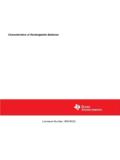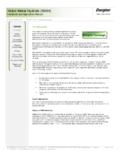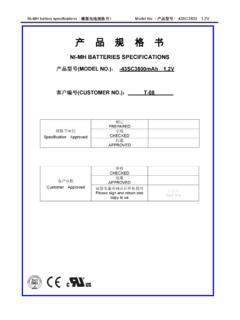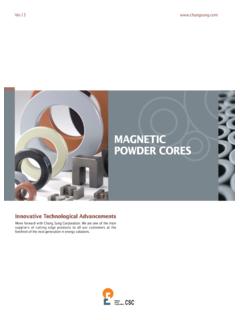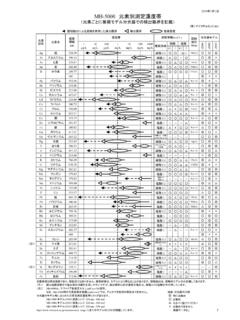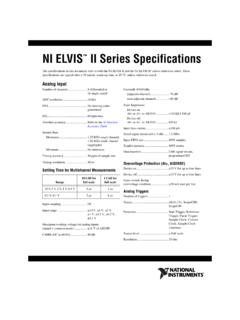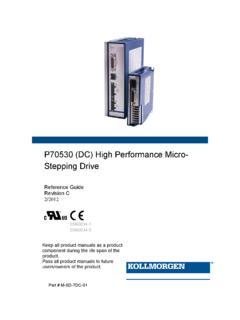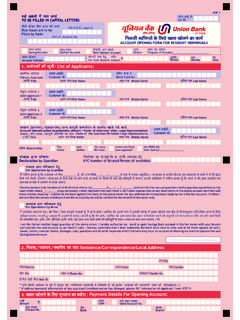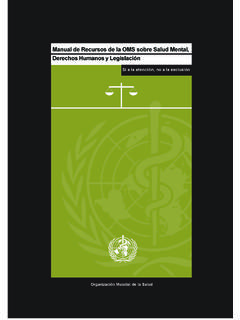Transcription of Battery Charging - TI.com
1 LM2576,LM3420,LP2951,LP2952 Battery ChargingLiterature Number: SNVA557 Battery CHARGINGI ntroductionThe circuitry to recharge the batteries in a portable product is an important part of anypower supply design. The complexity (and cost) of the Charging system is primarilydependent on the type of Battery and the recharge chapter will present Charging methods, end-of-charge-detection techniques, andcharger circuits for use with Nickel-Cadmium (Ni-Cd), Nickel Metal-Hydride (Ni-MH),and Lithium-Ion (Li-Ion) the Ni-Cd and Ni-MH cells are similar in their Charging characteristics, they willbe presented in a combined format, and the Li-Ion information will Charging INFORMATIONIn the realm of Battery Charging , Charging methods are usually separated into two gen-eral categories.
2 Fast charge is typically a system that can recharge a Battery in aboutone or two hours, while slow charge usually refers to an overnight recharge (or longer).Slow ChargeSlow charge is usually defined as a Charging current that can be applied to the batteryindefinitely without damaging the cell (this method is sometimes referred to as a tricklecharging).The maximum rate of trickle Charging which is safe for a given cell type is dependent onboth the Battery chemistry and cell construction. When the cell is fully charged, contin-ued Charging causes gas to form within the cell. All of the gas formed must be able torecombine internally, or pressure will build up within the cell eventually leading to gasrelease through opening of the internal vent (which reduces the life of the cell).
3 This means that the maximum safe trickle charge rate is dependent on Battery chemis-try, but also on the construction of the internal electrodes. This has been improved innewer cells, allowing higher rates of trickle big advantage of slow Charging is that (by definition) it is the charge rate thatrequires no end-of-charge detection circuitry, since it can not damage the batteryregardless of how long it is used. This means the charger is simple (and very cheap).The big disadvantage of slow charge is that it takes a long time to recharge the Battery ,which is a negative marketing feature for a consumer Charge RatesNI-CD: most Ni-Cd cells will easily tolerate a sustained Charging current of c/10 (1/10 ofthe cell's A-hr rating) indefinitely with no damage to the cell.
4 At this rate, a typicalrecharge time would be about 12 SimpsonNNational SemiconductorSome high-rate Ni-Cd cells (which are optimized for very fast Charging ) can toleratecontinuous trickle charge currents as high as c/3. Applying c/3 would allow fully charg-ing the Battery in about 4 ability to easily charge a Ni-Cd Battery in less than 6 hours without any end-of-charge detection method is the primary reason they dominate cheap consumer products(such as toys, flashlights, soldering irons).A trickle charge circuit can be made using a cheap wall cube as the DC source, and asingle power resistor to limit the : Ni-MH cells are not as tolerant of sustained Charging : the maximum safe tricklecharge rate will be specified by the manufacturer, and will probably be somewherebetween c/40 and continuous Charging is to be used with Ni-MH (without end-of-charge termination),care must be taken not to exceed the maximum specified trickle charge ChargeFast charge for Ni-Cd and Ni-MH is usually defined as a 1 hour recharge time, whichcorresponds to a charge rate of about The vast majority of applications whereNi-Cd and Ni-MH are used do not exceed this rate of is important to note that fast Charging can only be done safely if the cell temperature iswithin 10-40 C, and 25 C is typically considered optimal for Charging .
5 Fast Charging atlower temperatures (10-20 C) must be done very carefully, as the pressure within a coldcell will rise more quickly during Charging , which can cause the cell to release gasthrough the cell's internal pressure vent (which shortens the life of the Battery ).The chemical reactions occurring within the Ni-Cd and Ni-MH Battery during charge arequite different:The Ni-Cd charge reaction is endothermic (meaning it makes the cell get cooler), whilethe Ni-MH charge reaction is exothermic (it makes the cell heat up). The importance ofthis difference is that it is possible to safely force very high rates of Charging current intoa Ni-Cd cell, as long as it is not factor which limits the maximum safe Charging current for Ni-Cd is the internalimpedance of the cell, as this causes power to be dissipated by P = I2R.
6 The internalimpedance is usually quite low for Ni-Cd, hence high charge rates are are some high-rate Ni-Cd cells which are optimized for very fast Charging , andcan tolerate charge rates of up to 5c (allowing a fast-charge time of about 15 minutes). The products that presently use these ultra-fast charge schemes are cordless tools,where a 1 hour recharge time is too long to be practical. The exothermic nature of the Ni-MH charge reaction limits the maximum Charging cur-rent that can safely be used, as the cell temperature rise must be present, there are no makers of Ni-MH batteries that recommend Charging ratesfaster than (and the chances of that changing are not very good). Fast Charge: Possible Cell DamageCaution: Both Ni-Cd and Ni-MH batteries present a user hazard if they are fast chargedfor an excessive length of time (subjected to abusive overcharge).
7 When the Battery reaches full charge, the energy being supplied to the Battery is nolonger being consumed in the charge reaction, and must be dissipated as heat withinthe cell. This results in a very sharp increase in both cell temperature and internal pres-sure if high current Charging is cell contains a pressure-activated vent which should open if the pressure gets toogreat, allowing the release of gas (this is detrimental to the cell, as the gas that is lostcan never be replaced). In the case of Ni-Cd, the gas released is oxygen. For Ni-MHcells, the gas released will be hydrogen, which will burn violently if severely overcharged cell can explode if the vent fails to open (due to deteriorationwith age or corrosion from chemical leakage).
8 For this reason, batteries should neverbe overcharged until venting later sections, information is presented which will enable the designer to detect fullcharge and terminate the high-current charge cycle so that abusive overcharge will Charge Current SourceBoth Ni-Cd and Ni-MH are charged from a constant current source charger, whose cur-rent specification depends on the A-hr rating of the example, a typical Battery for a full-size camcorder would be a 12 Ni-Cdbattery pack. A recharge time of 1 hour requires a charge current of about , whichis for this cost-effective method to design a current source for this application would be to usean AC-DC wall cube to provide a DC voltage to a switching converter that is set up tooperate as a constant-current 1 shows a schematic diagram of a circuit which will fast-charge a 12V Ni-Cd orNi-MH Battery at and trickle charge it when the converter is shut off.
9 Note that the circuit must have a shutdown pin so that the end-of-charge detection cir-cuit(s) can terminate the fast charge cycle when the Battery is full (the LM2576 has alow-power shutdown pin built in). A temperature sensing end-of-charge detection circuit suitable for use with this chargerwill be detailed later in this LM2576 is a buck (step-down) switching regulator, used as a constant-currentsource set to It provides good power conversion efficiency (about 80%) and oper-ates from a wide input voltage constant-current feedback loop is established by holding the voltage at the Feedbackpin of the LM2576 at op-amp amplifies the voltage drop across the 50 m sense resistor (with a gain ) which locks the loop at the value of Charging current that causes the output of theop-amp to be The resistor RTR is included to provide a "trickle charge" current when the LM2576 isturned off.
10 Current flows through this resistor any time the input voltage is present. Thevalue of this resistor must be calculated based on the maximum allowable trickle chargecurrent for the Battery selected (equation shown in Figure 1).The total Charging current during fast charge is the sum of the current coming from theLM2576 (about ) and the trickle charge current provided by resistor following section details end-of-charge detection information and provides a circuitexample in Figure 3 which can be connected directly to the circuit shown in Figure 1and provide end-of-charge Detection for Ni-Cd/Ni-MHBoth Ni-Cd and Ni-MH batteries can be fast charged safely only if they are not over-charged. By measuring Battery voltage and/or temperature, it is possible to determine when thebattery is fully charged.










